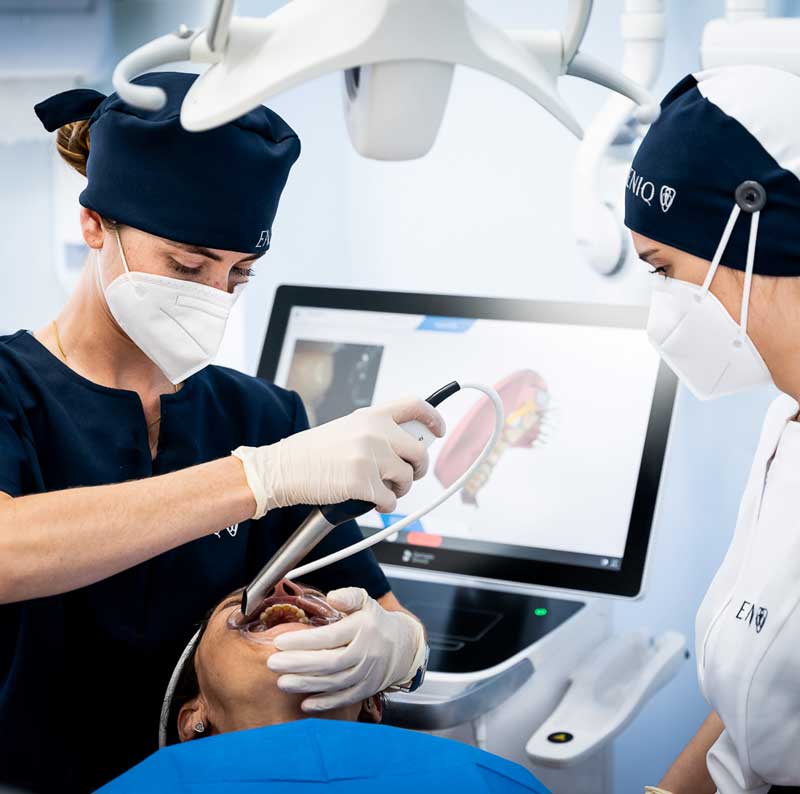

Conservative Reconstruction
Precise techniques to restore teeth while maintaining their integrity.
What are Dental Reconstructions?
Dental reconstructions are dental procedures carried out to restore the structure, function, and appearance of damaged or missing teeth. These procedures can vary in complexity and may involve different techniques and materials, depending on the specific needs of the patient.
Some of the situations where dental reconstructions might be required include:
- Advanced Dental Caries: When a dental cavity has progressed and significantly damaged the tooth's structure, a dental reconstruction may be necessary to remove the decay and restore the tooth with a restorative material, such as a filling or a dental crown.
- Dental Fractures: Teeth can fracture due to traumatic injuries, chewing hard foods, or due to weakness caused by decay or previous dental treatments. Depending on the extent of the fracture, different reconstruction techniques can be used, such as placing a dental crown, an inlay, or a resin restoration.
- Loss of Teeth: When a tooth is lost due to an injury, periodontal disease, or dental extraction, it is important to replace it to maintain oral function and aesthetics. Common methods for reconstructing lost teeth include dental implants, dental bridges, and dentures.
- Dental Malformations: In some cases, teeth may have congenital or acquired malformations affecting their shape, size, or position. Dental reconstructions can correct these malformations using techniques such as cosmetic dentistry, orthodontic treatments, or dental veneers.
- Dental Wear: Excessive wear of teeth due to bruxism (teeth grinding) or other habits may require dental reconstruction to restore the height and shape of worn teeth, thus improving chewing function and aesthetics.
It is important to note that dental reconstructions are performed by dentists and dental specialists who evaluate each case individually to determine the most suitable treatment based on the patient's needs.
What is the Procedure for a Dental Reconstruction?
The dental reconstruction procedure involves restoring or replacing one or more damaged or missing teeth. The process can vary depending on the specific needs of the patient, but here is a general overview of the common steps involved:
- Initial Evaluation: The first step is to schedule an appointment with your dentist for an initial evaluation. During this visit, the dentist will examine your teeth and assess the extent of the damage or tooth loss. You will also discuss your expectations and goals regarding dental reconstruction.
- Treatment Planning: Once your dental condition has been evaluated, the dentist will develop a personalized treatment plan. This may include a combination of different techniques and procedures, such as veneers, crowns, bridges, dental implants, or other treatments as needed.
- Dental Preparation: In some cases, before performing dental reconstruction, it may be necessary to prepare the existing teeth. This could involve removing decay, treating periodontal disease, or performing root canals to remove damaged dental pulp.
- Impression Taking: Once the teeth are prepared, impressions of your mouth will be taken. These impressions will be used to create accurate models of your teeth and to manufacture custom dental restorations, like veneers or crowns.
- Provisional Placement: While the permanent dental restorations are being fabricated in the lab, you may receive temporary restorations to protect the prepared teeth and maintain functionality and aesthetics.
- Placement of Dental Restorations: Once the custom dental restorations are ready, you will schedule another appointment with your dentist for their placement. During this visit, the restorations will be tried on and adjusted as needed to ensure a precise and comfortable fit. They will then be cemented or bonded in place.
Follow-up and Care: After the placement of the restorations, your dentist will provide you with specific guidelines for care and follow-up to maintain the health and functionality of the new dental structures.
Benefits
What are the Benefits of Performing a Bacteriological Test?
The main goal of conducting a bacteriological test for periodontitis is to identify the specific bacterial species present in the periodontal pockets, as well as to evaluate their quantity and activity. This provides valuable information about the bacterial composition of the patient's mouth and helps determine the risk and severity of periodontal disease.

Dental restorations based on new technologies offer a number of significant benefits for both patients and dental professionals. Some of these benefits include:
- Greater accuracy: Modern technologies, such as intraoral scanning and computer-aided design (CAD), allow for the creation of highly accurate dental restorations. This ensures a perfect fit and optimal functionality of the restoration, reducing the need for subsequent adjustments.
- Elimination of traditional molding: Restorations based on new technologies eliminate the need for taking physical impressions of the patient's mouth using unpleasant and potentially uncomfortable materials. Instead, intraoral scanners are used to capture precise digital images of the teeth and gums.
- Reduced treatment time: With restorations based on modern technologies, the design and manufacturing process can be carried out much more quickly compared to traditional methods. This means patients can receive their restorations in a considerably shorter time, reducing the number of dentist visits required.
- Aesthetic improvement: Modern technologies enable the creation of highly aesthetic dental restorations that perfectly match the natural appearance of the surrounding teeth. This is especially important in visible areas of the mouth, such as the front teeth, where aesthetics play a crucial role in patient satisfaction.
- Increased durability: Dental restorations made using advanced technologies tend to be more durable and resistant than traditional restorations. This is due to the precision in fitting and the quality of the materials used in the manufacturing process.
- Less invasive materials: With restorations based on new technologies, complete restoration can be achieved using minimally invasive materials. This means more natural tooth tissue can be preserved, promoting better long-term oral health.
- Customization: Modern technologies allow for greater customization of dental restorations to meet the individual needs and preferences of each patient. This includes the ability to adjust the color, shape, and size of the restoration to achieve optimal results.
In summary, dental restorations based on new technologies offer a number of significant advantages that enhance the patient experience, ensure high-quality results, and promote better long-term oral health.

How Long Does a Dental Restoration Last?
The lifespan of a dental restoration can vary based on several factors, including the type of restoration, the material used, the quality of dental work, the patient's oral care, and other individual factors. Generally, dental restorations are designed to be long-lasting, but they may eventually require repair or replacement over time.
Here is an approximate estimation of the average lifespan of different types of dental restorations:
- Dental Fillings (Composite Fillings): Composite dental fillings generally last between 5 to 10 years. However, their lifespan can be affected by the location of the filling and the amount of force it is subjected to during chewing.
It's important to note that these timeframes are general estimates and can vary based on individual cases. Proper oral care, including regular brushing, flossing, dental visits, and avoiding harmful habits like biting hard objects or chewing ice, can help extend the life of dental restorations. Additionally, it's important to follow the care recommendations and guidelines provided by your dentist.
What are the Benefits of Having Dental Restoration at ENIQ?
Undergoing dental restorations using technology can provide a range of benefits for both patients and dental professionals. Here are some of the most notable benefits:
- Improved Precision and Fit: Modern dental technology, such as digital impressions and computer-aided design (CAD/CAM), allows for highly precise and customized restorations. This ensures a perfect fit and optimal functionality, improving the final outcome and reducing the need for later adjustments.
- Reduced Treatment Time: Advanced technology in dentistry, like CAD/CAM systems, enables in-office fabrication of dental restorations more quickly and efficiently. This means patients can get their restorations in a single visit, instead of having to make multiple visits for restoration placement.
- Enhanced Aesthetics: Dental technology allows for superior aesthetics in restorations. For example, digital imaging and computerized design enable thorough analysis of the color and shape of teeth, allowing for better matching with natural teeth. This is particularly important in aesthetic restorations like dental veneers.
- Increased Patient Comfort: Modern dental technologies can also provide increased comfort for patients. For instance, digital intraoral scanners replace uncomfortable traditional molds, resulting in a more pleasant experience for the patient. Moreover, advancements in anesthesia and minimally invasive techniques can reduce pain and discomfort during the procedure.
- Improved Communication and Planning: Dental technology, like digital imaging and 3D models, allows dentists and patients to have better communication and understanding of the planned procedures. This facilitates informed decision-making and an anticipated visualization of the final outcome.
It's important to note that not all dental clinics have the same technology, so it is advisable to research and find a dentist who uses advanced dental technology if you want to take advantage of these benefits.
In summary, dental technology offers a series of advantages, such as increased precision, reduced treatment time, better aesthetics, increased comfort, and improved communication. These benefits contribute to enhancing the patient's experience and the outcomes of dental restorations.
¿Cuál es el precio de una reconstrucción o empaste dental?
Frequently Asked Questions
Do you have more questions about dental reconstruction or fillings?
It is the same, only insurance companies may use one term or the other, which is why there are different names for it.
Dental reconstruction is for small loss of dental structure, while for slightly larger losses, we recommend dental inlays as they are more resistant due to being made from high-pressure block materials.
Generally, unless the cavity is very deep, we try to complete the procedure in a single appointment. However, when it's close to the nerve or dental pulp, we sometimes place a protector and monitor the situation. In the next appointment, if there hasn't been any discomfort, we finalize the procedure.
During the dental reconstruction procedure, measures are taken to minimize pain and discomfort as much as possible. Before any treatment, local anesthesia is usually administered to numb the area and prevent any discomfort during the procedure.
However, you may experience some sensitivity or discomfort after the procedure, especially in the first few days. This is common and can usually be controlled with over-the-counter pain relievers as directed by your dentist. If you experience severe or prolonged pain, you should notify your dentist so they can evaluate and treat any underlying issues.
It's important to remember that everyone's experience and pain sensitivity can vary. Some dental reconstruction procedures may be more invasive and complex than others, which can affect the level of pain sensation. It's crucial to maintain open communication with your dentist, sharing any concerns or discomfort levels you experience so they can take the necessary steps and provide appropriate support.
In general, advances in dental techniques and the use of local anesthesia typically ensure that the dental reconstruction procedure is as comfortable as possible.
Services
All rights reserved © ENIQ Clinic 2025
Legal Notice · Privacy Policy · Cookie Policy
